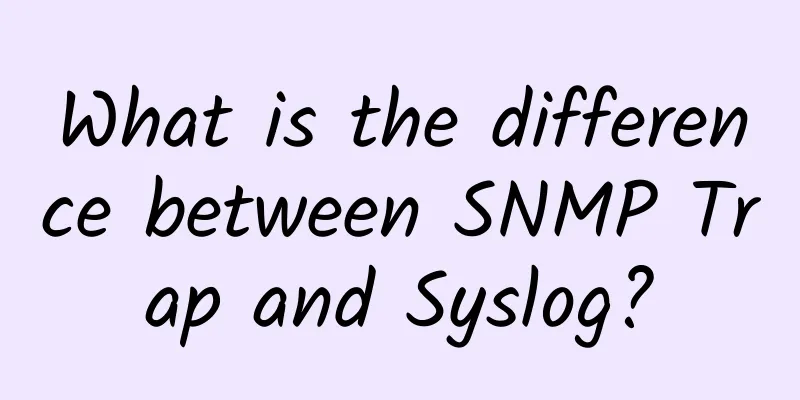What is the difference between SNMP Trap and Syslog?

|
System administrators use Syslog or SNMP Trap for monitoring. Both standards provide very similar monitoring information, but with different functions. Syslog can be used as a troubleshooting tool and is used when logs are needed for investigation. Although Syslog can be used for real-time summaries, it is usually only used for quick historical events. SNMP Traps can be used for device-based events. It provides real-time information and allows for better management. In most cases, using a combination of the two is the best solution depending on the specific situation. What is Syslog? Syslog is a message logging protocol used to exchange logs of different events from multiple devices. It consists of three parts: the Syslog device that generates logs, the Syslog relay that forwards the logs to the collector, and the Syslog collector (or server) that receives and stores the logs. The format of each log includes timestamp, host IP address, event message, severity, diagnostics, etc. Syslog allows you to choose the type of information captured. These logs can be anything from ACL events, configuration changes, authentication attempts, etc. The main function of Syslog is to collect logs for troubleshooting and monitoring. What is SNMP Trap? SNMP Trap is one of the five (Trap, Get, Get-Next, Get-Response, Set) event message types used by SNMP. SNMP Trap is generated by SNMP-enabled devices (agents) and sent to collectors (managers). SNMP Trap notifies SNMP managers in real time when important events occur. SNMP Trap uses thresholds configured on the agent. When an agent exceeds a threshold, an SNMP Trap is triggered and sent to the manager. SNMP Traps send data using numeric classes that are converted using SNMP MIBs (Management Information Bases). An SNMP manager does not request SNMP Traps, but can use SNMP Get messages (including other software) to poll information from an agent. The main function of SNMP Trap is to collect events in real time for management and monitoring. Similarities between Syslog and SNMP Trap Both are alert messages generated from remote devices and sent to a central collector; both provide similar "monitoring" information; both act on demand, and are not solicited. Difference between Syslog and SNMP Trap In general, the SNMP protocol defines a method for remote monitoring and configuration through other types of messages. Syslog is just an alert mechanism (same as SNMP Trap), and Syslog does not define any standards for remote configuration. Syslog provides more detailed information in the log messages. Although not a standard, Syslog is often used for troubleshooting and debugging, while SNMP Traps are used for device management and reporting. Syslog Messages vs. SNMP MIB Requests: SNMP Get Request messages can be used to poll from the agent using the local MIB. Syslog cannot be used to poll for information. |
<<: IDC: Global Ethernet switch and router markets mixed in the second quarter
>>: 5G! Your future is unimaginable
Recommend
The three major operators announced their performance at the beginning of the year!
Recently, the three major operators have successi...
Megalayer: US servers start at 199 yuan/month, US 100G high-defense servers start at 299 yuan/month
Megalayer's promotion this month still offers...
Operators are making full use of 4G, so what about 5G?
In the early stage of 4G development, the dividen...
A pitfall when using HTTP Client that you must avoid
Preface As software developers, we know that seem...
This year's 5G mobile phones must have these features!
[[387087]] This article is reprinted from the WeC...
A brief discussion on WebSocket interface testing
What is WebSocket WebSocket is a protocol based o...
GreenCloudVPS: AMD Ryzen+NVMe series from $24/year, Japan Osaka large hard disk VPS from $25/year
GreenCloudVPS, which we often call GreenCloud, is...
The most powerful remote access tool, no objection
ZeroTier and TailScale are foreign brand solution...
Analysis of the current status of cloud computing industry development, challenges faced by operators in their layout
Domestic operators are making great efforts to la...
Sharktech: 1Gbps unlimited traffic high-defense server starting at $79/month, 10Gbps unlimited traffic starting at $329/month, data centers in Los Angeles/Denver/Netherlands
Sharktech continues to offer 10Gbps port server s...
HostDare adds NVMe disk CN2 GIA line VPS, 15% discount starting from $30/year
After HostDare launched the Los Angeles NVMe SSD ...
Protecting the present and the future! Cisco helps enterprises resume work and production and ensure business continuity
[51CTO.com original article] The sudden outbreak ...
Major events in the global Internet of Things in 2017
Recently, iot.ru reviewed the major events of the...
[6.18] Alibaba Cloud: Hot-selling cloud server ECS with annual payment starting from 59.9 yuan
Every year, June 18th is an e-commerce shopping c...
C++ Programming Practice: IP Hash Load Balancing Algorithm
Today we are going to learn about NGINX. Nginx is...









